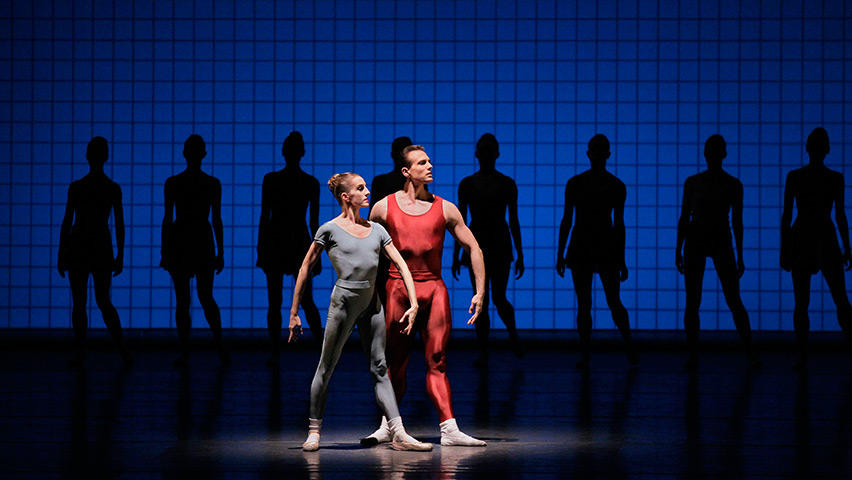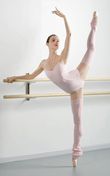The second movement of the ballet is set to the adagio Façades, also from Glassworks, and is as pure a manifestation of Balanchine’s “see the music, hear the dance” proto-concept as it gets. A long line of corps women in silhouette in the back panel of the stage perform staccato pulsations to match each beat of the music’s backbone. The pas de deux couple—clad in the same shiny unitards as the Rubric principals, yet in darker hues—performs stretchy movements to the soprano saxophone’s melody line floating above it. The steps in the corps’ endless march along the backdrop shift ever so subtly as the music also undergoes small variations. In one section (which the dancers call “rocking”) the women stand with their feet hip-width apart and simply teeter from side to side to the
The central couple can be thought of as having an illicit tryst, maybe stealing a moment at the dark end of the street. They could also represent one set of lovers’ storyline among many in the vast cityscape that was established by the populous mob in the Rubric section—and one can extrapolate that every single girl in the line in the back has her own secret love story as well. Or this couple too can be seen as lords of creation, their statuesque bodies sculpting glorious shapes in a haloed spotlight. Wendy says she imagines that she personifies the fluid architectural sketches of a master draftsman. Certainly, the supple, toned perfection of Wendy and Adrian against the rigid draft-paper scrim evokes Leonardo Da Vinci’s Vitruvian Man.
Façades is simultaneously inspiring and menacing (like life in New York City, I suppose): for although the soloists dance many meditative steps, they also have moments of apparent paranoia. Critic Jane Rigney thought that this section taps into the great fear people have of being lost in the crowd—of serving as cogs in the wheel of society. Fittingly, one of the variations that the corps women perform is referred to simply as “the machine.” Sometimes the soloists in this section melt, heads thrown back in ecstasy before they suddenly snap to rigid attention; and sometimes they hug themselves and collapse forward in defeat, or spastically swat at invisible demons in the air before them. This mimics the sustained breath work and febrile intensity of the saxophone solo as well as the paradoxical motor control that the dancers require of their bodies at any given time. For even when a leg unfolds effortlessly in adagio work, the dancer’s musculature must be flexing to create the illusion. Total relaxation in ballet is utterly impossible. There is always a quality of urgency as the performer is bounded by time and his/her own physical limitations; and I think that ballet more than any other art form provides the perfect mimesis for the fleetingness of human existence.
The Façades soloists luxuriate in sustained movements, but the steady countdown of the music and the tapering line of the exiting corps remind audiences all too cruelly of the inevitably limited time that dancers have in their careers (especially this weekend!) and by extension, all people have to inhabit their bodies. Beauty in this realm is finite, unnatural, and borderline frightening. Unsurprisingly, Wendy says that Bart Cook spoke of Robbins telling the principal dancers in this section to think of the horror of the sublime. In the Victorian sense the sublime is a suspended moment of pure fear, a brief glimpse of one’s mortality in the face of infinity. All performing readily approximates this idea: artists are forced to be fully present onstage, and the heightened temporal experience of one’s body in space taps into this phenomenon. This is especially true in dance performances, which require such full-blown physicality to begin with.
There is also the Romantic or Kantian conception of the sublime, which is a hyper-rationalized yet deeply embodied experience. This bears out in ballet equally well, for in every show a dancer attempts to achieve some unattainable aesthetic perfection in his or her mind’s eye, yet each performance is inevitably lacking in some aspect. A dancer must court failure with every outing on the stage, and the sacrifice of one’s body and mind to such an evanescent and ultimately futile (as far as absolute perfection is concerned) endeavor is humbling and emotionally draining, but also invigorating. Darren Aronofsky’s macabre film Black Swan supports this idea. Although Wendy says that Robbins wanted the dancers to feel the horror of the sublime in Façades, the audience feels it too. Sometimes the carefully wrought physicality and the uncompromising focus of a consummate ballerina like Wendy Whelan are truly terrifying even while being exquisitely beautiful. There is an inhuman, horrific beauty to the balletic ideals of perfection—and it may be added that very few dancers are able to achieve such purity of line and intent, of body and mind. Wendy is one of a very few who inhabit this top echelon.
I think Façades is very much about the body/mind connection—with the lead couple representing conscious thought and the corps standing in for the subconscious. One can look at the line of corps women who symmetrically separate and recombine as strands of DNA dividing and multiplying as they evolve—with occasional subtle mutations in score and steps—along their path across the stage. The double row of dancers also resembles the double helical structure of human life as they circle each other and realign, propelled along by the wispy flagella of their extended, ballerina-thin arms. The silhouette effect contributes to this idea, thrusting the women’s appendages into stringy black outline like mitochondria under a magnifying glass.
This backlit retinue of women could also represent the autonomous workings of the lower brain stem—their little pulses standing in for the human heartbeat, regulated breath, or the body’s automatic nerve response. The pas de deux couple could then symbolize the less tidy machinations of our conscious thought processes. While the corps’ steady march signifies the basic functioning of the body governed by the subcortical brain, the soloists’ movements denote the odd fluctuations between paranoia and ecstasy that are symptomatic of trying to understand the human condition through rational thought.


 RSS Feed
RSS Feed